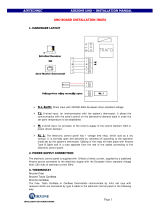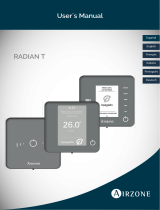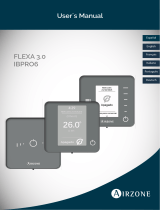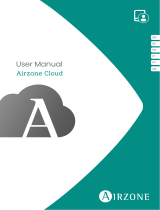
PLANNING THE INSTALLATION
Before beginning the physical installation, it is essential that the installer plan out the entire zoning
system. This includes deciding (along with the homeowner) the following:
• the total number of zones to be set up
• which spaces and which ducts are to be included in each zone
• the zone number (1 - 8) for each zone location
• the location for each zone thermostat
• the location for each damper in the ductwork system
• the module number to be assigned to each damper (1 - 8 for master modules which will be
connected to zone thermostats, 9 - 32 for subordinate modules)
• the routing path of the communication cable that will interconnect the components (for
troubleshooting purposes)
At the end of this document a Module/Damper Location Sheet, Zone Identification Sheet, and Zone and
Module Identification Sheet are provided to aid in the planning process.
CONNECTION
These are the recommended installation steps.
1) Have a layout drawing of the house and locate where each thermostat and each damper will be
installed. Define the address each module will be assigned and the path the communications wire
will follow . Keep that document in your records for future maintenance. Forms are included at the
end of this document.
2) Install all dampers according to your design and where the customer wants to have controlled
airflow. Be sure that the dampers are in good condition (not deformed). Install the dampers
according with the local building recommendations. Be sure that these two conditions are followed:
a) Mount the damper in such way that the motor is accessible
b) Be sure that the damper will be accessible for service.
3) If a bypass is required for this installation, install it now.
4) Lay out the communication cable and attach the cables to the connectors as indicated in the Training
Manual.
5) Install the Airzone Controller and the 12VDC power supply on their DIN rails, near the air handler
unit or furnace.
6) Wire the power supply, connect power on the Airzone Controller, and verify that the power LED is
ON
7) Disconnect the DC power from the Airzone controller.
8) Connect all the modules to the communication bus, thermostat sub bases and damper motor cables,
but do not install the thermostat touch screens.
9) Power on the Airzone Controller.
10) Verify that there is 3 VDC between the contacts + and – of the thermostat bases.
11) Install the thermostat touch screens into their bases
12) Proceed with the initial configuration for all master modules connected to the thermostats.
13) Using a separate Installation thermostat, proceed with the initial configuration of all subordinate zone
modules.
14) Configure any additional module parameters if required (remote temperature sensor, door contact,
motion contact, etc.)
15) Save the configuration in the Airzone Controller. (IMPORTANT:, follow the procedure explained in
the Training Manual).
16) Cycle the power OFF then ON in the Airzone Controller.
17) All dampers should be open.
18) Install the J2 jumper in the Airzone controller
19) Install the supply air temperature probe and connect to input 6 of the Airzone Controller.
(IMPORTANT: Do not proceed until this step is completed)
20) Proceed to install the iQ thermostat as indicated in its manual.
21) Connect the iQ communication bus in the Air handler/Furnace unit to the Airzone Controller (please,
see both Training Manuals)
22) Verify that the iQ thermostat shows under the current mode, “Zone Control”.
Error
Description Corrective action
Err 1
Damper blocked
Check that the zone control’s connection to the motorized system
has not shorted out.
Check that the motorized system is not blocked.
Err 2
No zone control sensor
Check that the circuit of the sensor connected to the zone control (if
any) is not open. Check the configuration of the “ZcPc” parameter.
Err 3
Zone-control sensor
short-circuit
Check that the circuit of the sensor connected to the zone control (if
any) has not shorted out. Check the configuration of the “ZcPc”
parameter
Err 4
Local communication
error
Check the connections and wiring between the zone control and the
thermostat
Err 5
Bus communications
error
Check the zone control’s connection to the bus.
Err 6
Damper not connected
Check the zone control’s connection to the motorized system. Check
that the motorized system is not free.
CONFIGURATION
The Zone Module has a number of parameters that have to be configured. As indicated before, the Zone
Module requires the use of a Zone Thermostat to proceed with its configuration.
This is a list of the parameters, its description and ranges of selection.
Parameter Description Value
ZCOn
Zone Module Role
MAS : Master
Sub : Subordinate
ZCid
Zone Module ID Number (the
address of the zone module)
If Master : 1 to 8 (this defines the zone
number)
If Subordinate : 9 to 32
perC
Zone weight Percentage 10% to 100%
tCiD
(for subordinate modules only)
Zone Number
Must match one of the zone numbers assigned
to a master module (1 - 8)
zCpC
Zone Module Probe Configuration
Off : default value
rpt : measurement by a remote temperature
sensor
ZCSI
Zone Module Sleep Input (motion
detector)
Off : default value
NO : activates when closing the circuit
nC : activates when opening the circuit
ZCrI
Zone Module Remote Input (door
or window contact)
Off : default value
NO : activates when closing the circuit
nC : activates when opening the circuit
Sbdt
Stand By Display Temperature
At : ambient temperature
St : set point temperature
OFSt
Offset (adjust the zone temperature
reading)
-5ºF to +5ºF (-3 to +3°C)
zCfV
Zone Module Firmware Version Current firmware version (Read Only)
ZtfV
Zone Thermostat Firmware Version Current firmware version (Read Only)
SCfV
System Controller Firmware
Version (Airzone Controller)
Current firmware version (Read Only)











